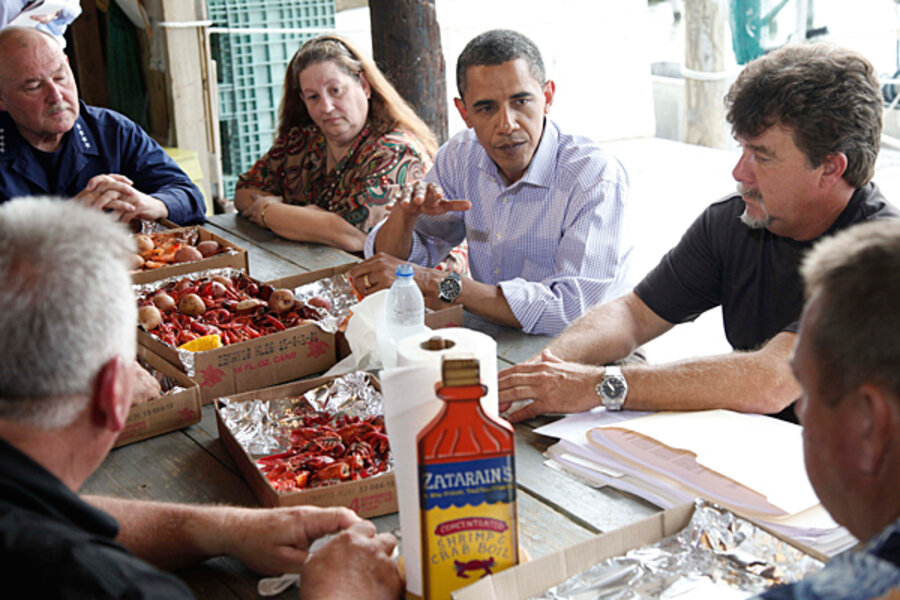BP oil spill poses growing worry for US seafood restaurants
Loading...
Outside the Gulf of Mexico, where the BP oil spill besets the coastal states, the US seafood industry is bracing for a crisis that is not connected to a region but to a perception: that any seafood, no matter where its origins, may be contaminated by oil.
Far north of the Gulf, restaurant owners and wholesalers are tracking where the oil slick is traveling and trying to glean just how much impact it will have on menu prices and consumer perception. There are already reports of tar balls and oily substances in the Florida Keys, and worries are rising that this summer’s hurricane season will push the oil around Florida's southern tip, where it could enter the Gulf Stream and head north to the fishing grounds off the mid-Atlantic coast.
Jim Filip, owner of Doris & Ed’s, a 90-seat seafood restaurant in Highlands, N.J., is tracking the oil’s path via computer projections he finds on the Internet. He stopped buying seafood from the Gulf four weeks ago, not because he believes it is tainted, but because he doesn’t want to lie to customers who are now asking about the origin of his shrimp and oysters.
IN PICTURES: The Gulf oil spill's impact on nature
Mr. Filip worries about the ways the oil spill threatens his business: how high seafood prices may rise and how long it will take the oil-ruined oyster beds in the Gulf to be clean again.
“I can’t think of anything worse. We don’t know where [the oil slick] is going to go and what it’s going to do to you. It’s a waiting game,” he says.
For restaurants far outside the Gulf, what is known is that customers are concerned. Since the Deepwater Horizon oil rig exploded 40 miles off the Louisiana coast and sent oil into fertile fishing areas, restaurateurs are working to assuage the fears of worried diners about where their food is coming from.
“They ask us if the fish is from where the oil is. They ask us all time,” says Linda Blyth, who works at Go Fish!, a seafood restaurant in Rehoboth Beach, Del. For Ms. Blyth, the questions are especially worrisome because her restaurant specializes in Icelandic cod, which she says is fished off the coast of Canada.
Consumer perception “is absolutely one of biggest concerns right now,” says Gavin Gibbons, spokesman for the National Fisheries Institute, a nonprofit advocacy group for the US seafood industry. Consumer hesitancy about seafood is not necessarily warranted, he says, considering that 83 percent of the seafood Americans consume is imported.
Oysters raise the greatest concern among consumers, and for good reason: 70 percent of this country’s supply comes from the Gulf, says Mr. Gibbons. To date, 32 percent of federal fishing waters in the Gulf are closed to commercial and recreational fishing. He says wholesalers are responding to the potential shortfall by raising prices on Gulf product between 10 and 30 percent.
It is not yet known how the oil is affecting the marine life in the Atlantic. Gibbons is optimistic, saying that migratory species, unlike species bound to a seabed, will simply move in the opposite direction of water contaminated with large plumes of oil.
“We’re watching that and certainly it’s a concern, but it’s also a different dynamic,” he says. “There’s not a lot you can do in preparing for it.”
Blyth says she worries about friends who own local crab houses, who depend on crab pulled up off the South Carolina's crab-rich coast.
For them, a movement of oil around the tip of Florida “could be detrimental” to their livelihood. South Carolina is "a hop, skip, and a jump from Florida,” she says.
IN PICTURES: The Gulf oil spill's impact on nature
Related:





